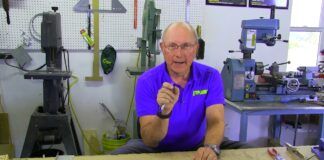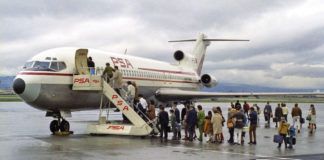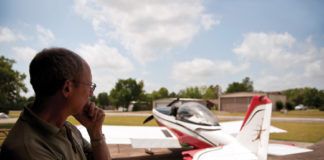Many years ago, when I was broke, a friend got me a job. I needed that job, but it required commuting by car, 35 miles each way, through Los Angeles traffic. That took more than 2 hours each day, and I swore that I would never again waste such a big piece of my life doing something I despised so much.
So it was not altogether good news when my employer, Vans Aircraft, announced that the company was building a new facility about 30 miles away. The only possible route, straight through the heart of Portland, Oregons nightmare rush hour traffic, would take an hour each way. At least. There was no question of moving, because Id promised my son that he would not have to change schools during his high school years. There was, however, an alternative that I didn’t have in Los Angeles: I work for an airplane company located on an airport, and Id built an RV-6. Even in Oregon, I could easily fly to work several months a year.
That sounded better. So I tried it. I enjoyed it, too. The trouble was that flying to work was not what Id built my RV-6 to do. It was a great traveling machine, not a short-hopper. On a long cross-country, speed is a useful tool, but elapsed time for a 22-mile flight is not much different in an 80-mph airplane or a 180-mph airplane. I ended up flying the trip at 2000 rpm to save fuel, but even so, 3 gallons of avgas a day added up. I needed an economical, cheap commuter airplane, and I pondered the question as I flew back and forth.
It should be metal. It should have an essentially disposable engine that burned as little fuel as possible. It had to have an enclosed canopy with heat and a cockpit that would fit my 6-foot-3, 245-pound frame. It should be dirt simple. It should have a slow landing speed and a tough cabin/roll bar, in case that engine self-disposed somewhere along the way. It had to be really cheap, like less than $5000. Speed was irrelevant, aerobatic capability was unnecessary, looks were unimportant. Even handling qualities, as long as there was nothing unsafe, didn’t matter much. Surely, somewhere out there was an airplane like that.
Actually, Not Too Many
No certified airplane was cheap enough. There were quite a few small Experimentals with inexpensive two-stroke engines, but the metal requirement weeded out about 90% of them. The handsome little Hummelbird just isn’t built for people my size. I liked John Monnetts Sonex, and I could fly it as a single-seater (I weigh about twice what John does, so that should work out), but even the scratch-built version was more than I could spend. The most promising candidate was almost literally in my back yard, Dick VanGrunsvens RV-5.
Built in the early 1980s, this remarkable little airplane weighed just over 300 pounds in its original form. With a Rotax 447 it had exceptional short-field capability, good speed, a swing-wing that let it fit in an 8-foot-wide hangar slot or trailer, and by all accounts it flew well. The only drawback was that I couldn’t fit in it. I know because I tried. I found the fuselage sitting in the corner of Vans hangar one day, and I tried to find a way to get in the minute cockpit. I just couldn’t get my knees under the panel and my butt in the seat. This was disappointing, because in every other way it was exactly what I was looking for.
One night, poring over old issues of Sport Aviation, I found a simple all-metal airplane powered by a direct-drive Evinrude outboard engine. It had about 28 horsepower, and it was as simple as the RV-5, with a larger cockpit. I could find nothing else about the airplane except the one article, which I showed to my friend Ken Krueger, chief engineer at Vans.
Krueger has been responsible for many of the improvements in RV kits over the last few years, and had a lot to do with the successful RV-7, RV-9 and RV-10 airplanes. It wouldn’t be too tough to build something like that, he said. You could make all the parts on the tools here, and maybe buy the metal from Van.
Yeah, but Im an English major. I fly airplanes, I read about airplanes, I write about airplanes, and Ive built an airplane, but I don’t know how to design airplanes. All those numbers! All that playing around with equations that have parentheses and radicals and xs. I get a rash just thinking about it, but I know its all necessary, so Im not going to just eyeball an airplane together. I want something that I know has been thought out. I need…I need…a guy like you! And you hate commuting by car, too!
There You Have It
So we decided to design and build an airplane. A simple sheet aluminum airplane that would haul one person to work and back. Something we could build in our spare time, and something we could afford. He would design it, Id pay for the big stuff. Wed work together to build it. If it worked well, wed knock out another and each have one. Sounds like fun!
Its now time for a little disclaimer: Although both of us work for Vans Aircraft, this airplane is a purely private, fun-after-work project in the true spirit of the education and recreation Experimental category. Neither Vans Aircraft nor Dick VanGrunsven have taken any part in designing, building or flying it. We have no intention of making plans or kits available for it, but we can share the fun and learning we had designing and building the thing.
The next week we both stayed after work to talk over the basics of what this new wonder of the skies might look like. We arrived at several basic parameters:
A 45-mph landing speed.
At least Utility category strength. Thats a load limit of 4.4 G.
It had to carry both of us-not together. We are both about 6-foot-3. The problem is that I weigh the aforementioned 245 pounds-more with winter clothing. Krueger has to stuff his pockets with rocks and drain the water fountain to reach 165 pounds. Life is not fair.
It had to stay in the air for at least 1.5 hours.
It had to have sufficient climb performance with me aboard that it wouldn’t be scary.
We could not spend more than $6000, less would be better.
We would test the major portions of the airframe for strength before we produced a flying airplane and flew it.
We envisioned an airplane with a 350-pound empty weight and a 650-pound gross.
Once wed decided what we wanted, we looked at how to build it. We had both been through intense airplane projects, and we determined that this one would not rule us. We would not give up other pleasurable pursuits, nor would we sacrifice time with the important people in our lives: our wives, kids and friends. Krueger and his wife, Susan, have a daughter (Amy) who will be young only once. My wife, Camilla, is a professional musician who plays in several orchestras and chamber groups. Classical music is an important part of our lives, and I go to a lot of concerts. If that meant the airplane would take longer to finish, so be it.
The Design Emerges
We considered many choices for the basic layout of the airplane. With all due respect to Burt Rutan, we think the reason the conventional engine-in-front, tail-in-back airplane design became conventional is that it works. Both of us had already built such airplanes, so we decided to stick with what we knew.
We settled on a single-seat, tractor-engine, tricycle-gear concept. A taildragger would have been slightly simpler, and both of us are comfortable flying them, but neither of us see much point in it. Glenn Curtiss was right in 1911 or so: Put the third wheel up front, the airplane goes straight.
Our experience as builders taught us that there is no simpler, easier, cleaner way to build an airplane than with riveted sheet metal. We’ve heard all the arguments, but we’ve both owned and maintained tube-and-rag airplanes, and we’ve both built sheet-metal airplanes, so we’ve learned the differences between those construction methods firsthand. Those who favor composites are welcome to their opinions, but it is our intention to spend no more than an hour sanding fiberglass during the entire construction of this airplane.
Because Oregon winters are gray, drizzly affairs, with constant low ceilings and short daylight hours, it was likely that the airplane would be stored for three or four months a year. Folding wings seemed overly complicated, so we eventually stole a page from John Thorps book and decided on a one-piece low wing that simply dropped out the bottom of the fuselage. The advantage was that all the wing controls could be left intact, and the rudder controls in the fuselage would be undisturbed as well.
A removable wing more or less dictated that the fuel be kept in the fuselage, to avoid having to drain tanks and disconnect fuel and vent lines every time it came off. Neither of us liked the idea of flying with several gallons of gas between the pilot and the engine, so we decided to put a tank in the upper fuselage, behind the pilots head. We could protect the tank with the same roll-over structure that would protect the pilot and, as an added attraction, the height of the tank allowed us to use a gravity-feed fuel system and dispense with the fuel pump. We planned to fill the tank with explosion-preventing foam.
The landing gear would consist of simple tapered steel rods. Steve Wittmans idea has worked for thousands of RVs, GlaStars, Tailwinds and many others. It is hard to think of a simpler way to put wheels on an airplane, and besides, Krueger had done some airplane painting for Harmon Lange, who has made more tapered rod gear legs than anyone else in the world. He agreed to trade a set of gear legs for Kruegers labor, which helped with the cost requirement. John Monnett, drawing on vast experience with airplanes in this weight class, advised using aluminum Azusa wheels, and we found a local source.
The Engine Choice
One of the first things a designer wants to know, after the basic configuration is decided, is what will be used for the powerplant. In an airplane like the one we were contemplating, there were several choices.
First would be one of the little Rotax two-strokes. They are light, simple and relatively cheap. But during our deliberations, we looked at each other and almost simultaneously said, Naaah…no two-strokes. Despite their good qualities, they are noisy, touchy, thirsty little beasts, and we just didn’t want to deal with them. This choice cost us quite a few pounds, but we made our decision and moved on to four-stroke engines.
There were not a lot of candidates in our power, weight and price range. Small Continentals were too heavy. The four-stroke Rotax 912 is a lovely thing, but we didn’t need 80 hp, and new they cost more per horsepower than a Lycoming! Because 912s are virtually impossible to find on the used market, we moved on. The Jabiru was probably the best candidate, but price took it out of consideration. The little two-cylinder HKS engine was just coming on the market and, boy, did it look perfect. But nobody really knew how it would last, and they werent cheap enough either. I looked at Mazda direct drive (too heavy), a BMW conversion (almost unknown in the U.S. at the time, so no good information), a Subaru (too heavy, even direct drive) and several others. I even hunted down the specs on the late and unlamented two-cylinder Franklin.
But in the end it came down to a Volkswagen.
Dr. Porsches air-cooled boxer motor may not be an airplane engine, but if you squint, it looks a bit like one. A lot of VW engines have been used in airplanes, and over the years people have developed good data on what makes them live and die. They are simple, requiring no reduction drives, liquid-cooling systems or special machining. High quality parts are readily available, and the engines themselves are (at least by airplane standards) as cheap as grass clippings.
The Mel Factor
Besides, I know Mel Ellis, who has worked on VWs almost from the time they appeared in North America. He started with a large VW distributorship, moved on to successfully run his own VW repair shop for many years, and has built three VW-powered airplanes. The perfect engine guru.
When we described our requirements, Ellis recommended a 1915cc version with a forged crank. We decided to keep it simple, with single distributor-fired ignition and a carburetor. He estimated that such an engine would weigh about 160 pounds and develop 55 hp all day long. We asked him to build us one, and Ellis, who at 76 years of age is an inspiring source of energy and enthusiasm, dived right in.
Once the engine decision had been made, we could firm up other parts of the design. We decided to make the fuselage wide enough to contain the engine without cowl cheeks. This gave us a generously wide cockpit and raised the possibility of a simple drop-head cowling that could be formed from single-curve metal. We liked this because we don’t have the tools to produce compound curves in metal and, faced with producing them, would have to resort to fiberglass. Also, any small baggage we carried could sit beside us, directly on the c.g.
While the basic design evolved in the computer, the inevitable started to happen. We found ourselves suffering from target creep. In the beginning I figured on building a tube on a plank held together by round-head pop rivets. Airplane designers just cant leave it at that, though, and soon we were nosing around for ways to produce a really clean airplane and get the best performance possible from the 55 hp the VW promised. We decided on flush solid rivets (more work, but at least they’re cheaper!), a faired landing gear, pressure cowl, etc.
We also realized that given our engine choice, our original weight estimates were unrealistic. We moved them up to 450 pounds empty with a gross of 850 pounds, but kept the same strength and landing speed requirements.
Given these parameters, Krueger quickly worked up a wire-frame design. Both of us have had the chance to fly the RV-9 extensively and have been impressed with its wing, so we copied its airfoil. A surprisingly large 22-foot wing with a chord of 54 inches was necessary to achieve the desired 40-mph stall speed. To keep it simple, we dispensed with flaps. The fuselage was longer than Id expected, but gave fairly small tail surfaces good authority at the end of a long arm. (Somewhere along the line, I began calling this airplane Pipsqueak, and people who were aware of the project probably remember that name. Krueger didn’t care for it and never used it. A straw poll at an EAA chapter meeting bolstered his point of view. I know when Im outvoted, so Ive fallen back on KK-1.)
The longest journey begins with a single step, they say. We took ours, (they never tell you to make sure that step isn’t off a cliff!) and set to work. Next month, we start to cut metal.




